|
Executive Editor

Join Date: Aug 2006
Posts: 29,160
|
|
 The Zune Review, Part 2: Software Install & Initial Setup
The Zune Review, Part 2: Software Install & Initial Setup
After I finished unpacking the Zune box, it was time to fire it up and get it installed on my laptop, a Fujitsu P7020D. It's not a powerful laptop by any means – a 1.2 Ghz Pentium M CPU, 1 GB of RAM, and an 80 GB, 4200 RPM hard drive. It's great for traveling though, with its small 10.6" screen and excellent (10 hour) battery life, so it's a logical companion to a digital media player like the Zune. I inserted the Zune CD at 2 PM, and proceeded to have a very frustrating next five hours. What happened? Here we go...
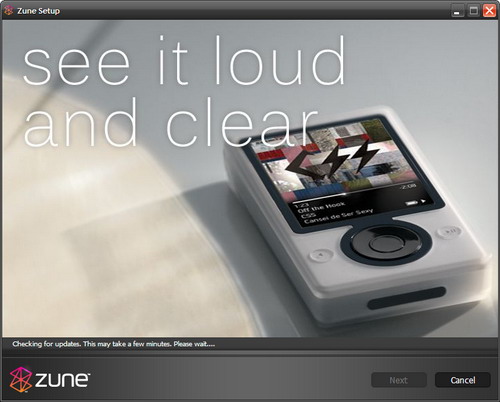
I've already done a screenshot-heavy, super detailed walkthrough of the Zune Desktop software setup, so in this review I'm only going to include setup screenshots that are interesting or different from my previous Zune-less install. The first thing the software does is check for updates - presumably, checking for a newer version of itself. That's fine, but it took a full two minutes to confirm that there was no update. That's quite a while, though perhaps there were many other people installing the software and the update server was sluggish. But if Picasa can check for an update in one second, this software should be able to as well.
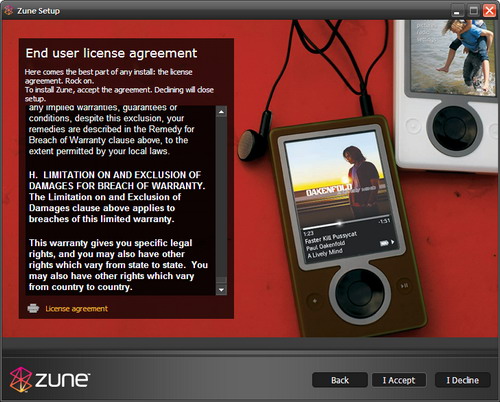
After the update check, I was presented with the end-user license agreement. I gave an audible chuckle when I read the first sentence: "Here comes the best part of any install: the license agreement. Rock on". Nice to see that someone on the Zune team has a sense of humour! It took about four minutes for the install to complete, a far cry from some of the other install horror stories I've heard about. Ex-Digital Media Thoughts Contributing Editor James Fee contacted me today over IM to ask if I knew how to really uninstall the Zune Desktop software, because he couldn't get it to work on his desktop PC (it installed fine on his laptop). Ryan Block at Engadget had some problems as well, so there's clearly some sort of significant issue here.
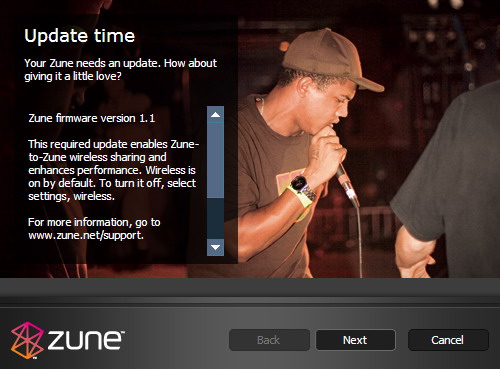
After the install completed, I was prompted to connect my Zune. I did so, and very quickly the software indicated that there was a new firmware update for my Zune, taking it to 1.1. As the screenshot shows, this update adds wireless sharing. It amazes me that, out of the box, the Zune didn't have this feature working. The Zune team really did finish this product after it was too late to get the needed software onto the device!
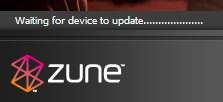
The update happened fairly quickly - it updated the Zune, rebooted it, and the PC re-connected to it. The entire process took perhaps two minutes. Slick and completely painless. If it's always this fast and easy (very Xbox 360-like) then I hope the Zune team releases one every couple of months with new features and fixes.
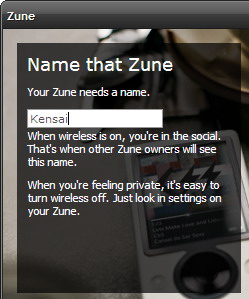
After the update, I was prompted to give my Zune a name. You have to love the re-invention of the English language ("You're in the social" , but having butchered more than a few words in my time, I shan't throw stones. I like the casual, friendly tone of the entire setup process. , but having butchered more than a few words in my time, I shan't throw stones. I like the casual, friendly tone of the entire setup process.
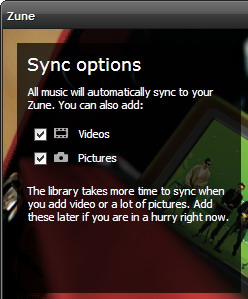
This was the ill-fated screen where my decision turned things sound for the next five hours. When it asked me if I wanted to have videos and pictures on my Zune, I thought "Sure, cool!" and checked off the boxes. Yes, it did give me the warning about it taking "more time", but I thought they must have improved this over the old Windows Media Player 10 process, right? Right? Wrong.
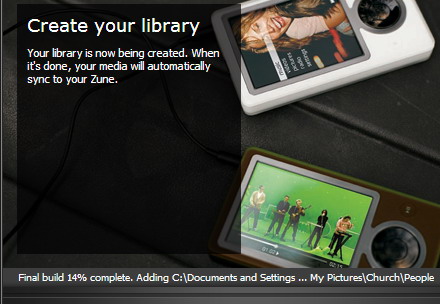
After clicking Next on the previous screen, the Zune proceeded to create my library. I should point out that I only had a few albums of music on my laptop, having brought all 70 GB of my music on an 80 GB portable hard drive. I had recently finished "scrubbing" my music library by correcting all bad metadata, scanning and embedding album art into each one, correcting file names and cleaning up the genres. I had a few videos on the hard rive, but I also had all of my photos. All 15,425 of them. When I saw that the Zune Desktop software was crawling through each folder, one by one, I groaned because it wasn't very fast at all. I saw that there was a skip button, so I clicked it.
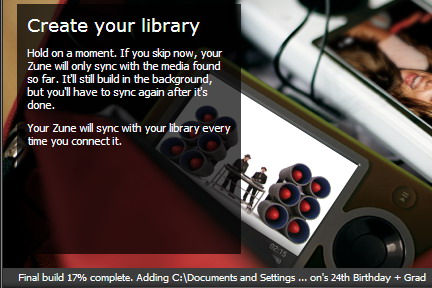
I've never really been warned by software like this before, and since I wanted to try and emulate the normal experience that an end-user would have, I decided to leave it.

The scanning process was fairly intensive, using up between 40% and 75% of my CPU cycles and taking up a good chunk of RAM. I was wishing my laptop had a fast Core Duo 2 processor in it. It took about 5 minutes for this process to complete, and after that I thought I was in the clear. Boy was I wrong. The main Zune software interface loaded, and it looked very much like Windows Media Player 11 with a different skin. I noticed that my laptop was still labouring though, so I looked around for why...

My jaw hit the floor when I saw what it was doing: converting (resizing) all 15,450 images from the original resolution down to 320 x 240 resolution! When I had told the setup software that I wanted to include my pictures, I was honestly expecting some sort of intelligent decision such as giving me the last 60 days worth of photos, or further prompting for which folders I wanted to include. I did not expect the software to convert, one by one, over 15,000 images - that's simply insane. The conversion process was incredibly CPU intensive, using up between 70% and 90% of my CPU cycles, and chewing up around 150 MB of RAM. Even on a fast dual CPU system, converting this many photos would take a long time. Still determined to experience the setup as a normal user would, I decided to let it continue, just to see how long it would take. I proceeded to do some email, write this review, and update my sites, all on a very sluggish laptop. A little over four hours later, it was only at 82% complete. I clicked Stop Sync, knowing it was past time to give up.
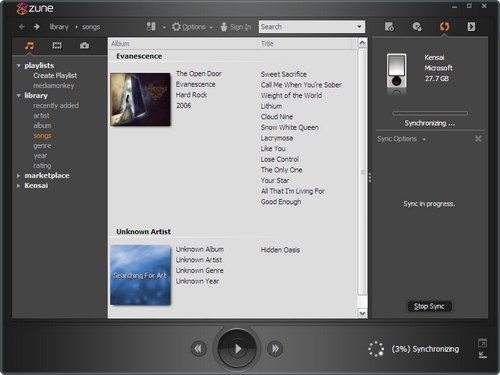
Look at that: 3% complete after about 10 minutes. Isn't that depressing?
I can hear the Zune product managers screaming "But Jason, who has over 15,000 photos - that's an extreme case scenario we didn't test for!" Yes, that's a lot of photos - but unlike MP3 collections, it's very easy for consumers to rapidly grow their digital photo collection. I cull my photos with brutal efficiency (like Stalin going after enemies of the state), and I don't have children yet, so I can easily see a family with kids tacking on 2000 or more photos per year. Let's say that the Zune team tested with half that amount - 7500 photos - why would anyone think that 2 hours of processing was acceptable? This is a badly broken user experience that smacks of a lack of testing, or a poor decision by someone who knew this would happen but thought it was "ok". A much better solution would be to implement some logic in the software that if there's more than, say, 1000 photos, the software would prompt the user for a more granular approach - offering up a solution like "Put the last 60 days worth of photos on my Zune" or "Allow me to select which photos to include".
After that disaster, I was starting to sour on the Zune experience - I was really hoping that the Zune software wasn't equally flaky in other ways. It came to the part where it was asking me to create a Zune.net account, and I tried to log in with my Passport account that's linked to my Xbox Live account. Not surprisingly, it didn't work. Being from Canada, I was fully expecting to have trouble with this part, and I certainly fault no one on the Zune team: it's only meant to work for people located in the USA. If your Passport is based on another country, you get this rather generic looking answer:
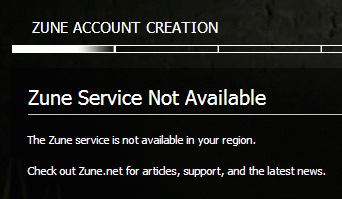
Rather than being strictly IP-based, which can be fooled with proxies, the service was probably flagging my Passport account because I have my location to set to Canada. I logged into my Passport account and changed my address to 1 Microsoft Way, Redmond, WA, USA. I tried again...no luck. It's probably tied to the billing address on the account, which is problematic because I'd have to remove the credit cards from my account in order to complete the ruse. Instead, I created a brand new Passport account from scratch, one with no billing information. The Zune.net accounts are tied to Xbox Live accounts, so you can't select a Zune.net name if someone already has it on Xbox Live. This is nice, because it prevents someone with a Zune from taking your gamertag.
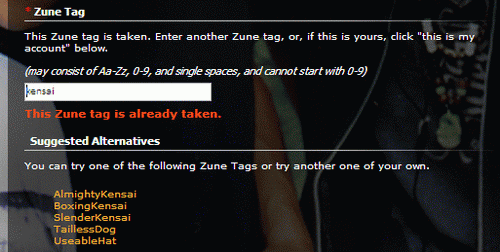
The above is what you see if you try to register a name that's already taken. The auto-generated names are always funny: some of them make sense, because they contain the original word, but UseableHat? Well, it's unique, that's for sure. Since I was pretending to be American in order to get access to a Zune.net account, only one username seemed appropriate...
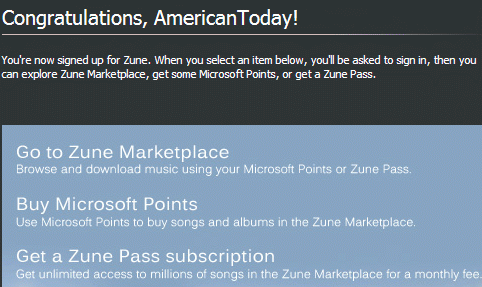
AmericanToday - that's me! If I was based in the USA, and already had a gamertag from Xbox Live, this whole process would have been very painless - so for most Zune buyers, this is a fast process. Each Zune comes with a free 14-day trial of Zune Pass, the $14.99 USD per month unlimited music subscription.
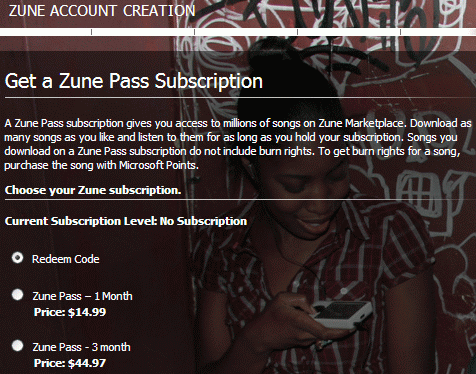
I think it's excellent that Microsoft is allowing people to experience the 14 day free Zune Pass, especially since it doesn't require a credit card. Once people give it a try, I think many will choose to continue using it - it's hard to say no to all that music for the price of one CD a month.
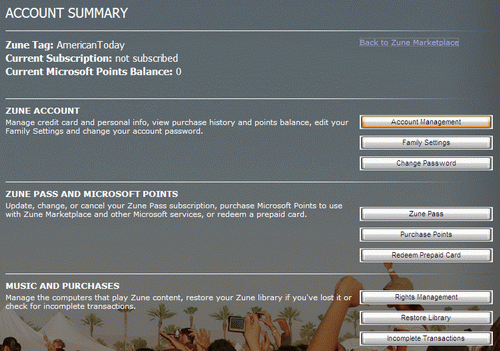
The Account Summary page is a easy to use, centralized location for controlling every aspect of your account - including ordering more points, and redeeming prepaid points cards purchased from stores.

Back to the massive photo sync - I wasn't problem-free yet, because remember 82% of the photos had been resized and put onto the Zune. The first step to fixing the problem was to tell the software to ignore the folders that had my photos in it - I have to treat the Zune software just as gentle as I do Windows Media Player 10/11, because it can't handle loads of data (still!). Next, I had to delete the photos from the library. You'd think that this process would go quickly, but it took almost a full hour to delete all of the re-sized images. I can't figure out why this process is so horribly slow, but it gets worse: removing the images from the Zune also takes a shocking amount of time.

I must have stared at the above image for 30 minutes or more - it took the Zune a great deal of time to process all of the image removals. The entire process was giving me a headache - especially when my laptop coughed up a Blue Screen of Death in the middle of all this. The laptop is remarkably stable - I haven't seen a BSOD on it in months, so this was a surprise. It crashed so hard there was no record of it in the system logs.
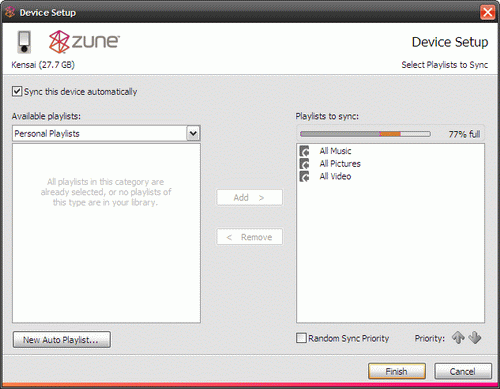
Lastly, I had to change the auto-sync playlist to tell it to only sync "All Music", not "All Pictures" or "All Videos". The playlist functionality here is powerful, but it's not very intuitive. I could create an Auto Playlist that would sync 500 of my photos, but there's no criteria for "most recent" for instance. It's not something most people would understand - decisions like how many photos and how many videos are synchronized should be made during the initial setup.
At around 8pm, nearly six hours after I had started the setup, I finally had the Zune desktop software, and the Zune itself, back to a state that I could actually work with it. This goes without saying by this point, but it's completely unacceptable that:
1) The Zune software tried to import 15,000+ photos
2) The Zune software is so slow at deleting photos or trying to recover from the initial import
3) The Zune itself is so slow at deleting items from the internal hard drive
Will this happen to everyone who buys a Zune? No, certainly not to this extent - but I'm sure there are a lot of early adopter types like myself, buying Zunes, that will have 5000+ photos - and if it takes then even 1/3rd as long as me to recover from a disaster like this, I'm sure they'll be just as frustrated as I was. Ultimately, this part of the process was just as bad as using my Zen Vision:M with Windows Media Player 10, and that's not a good thing. The goal of the Zune team is supposedly to make a better player, and experience, by controlling the entire process from end to end. They have a long way to go - Windows Media Player 11 needs more than a new skin and a few icons to be as fast and simple as it needs to be.
Up next: using the Zune for photos, audio, and video. I'm in meetings all day on the 15th, so part three will probably not be published until late on the 16th.
Jason Dunn owns and operates Thoughts Media Inc., a company dedicated to creating the best in online communities. He enjoys mobile devices, digital media content creation/editing, and pretty much all technology. He lives in Calgary, Alberta, Canada with his lovely wife, and his sometimes obedient dog. And yes, he really is writing this at 1:49 AM.
|
 Similar Threads
Similar Threads










 , but having butchered more than a few words in my time, I shan't throw stones. I like the casual, friendly tone of the entire setup process.
, but having butchered more than a few words in my time, I shan't throw stones. I like the casual, friendly tone of the entire setup process.


















 Threaded Mode
Threaded Mode